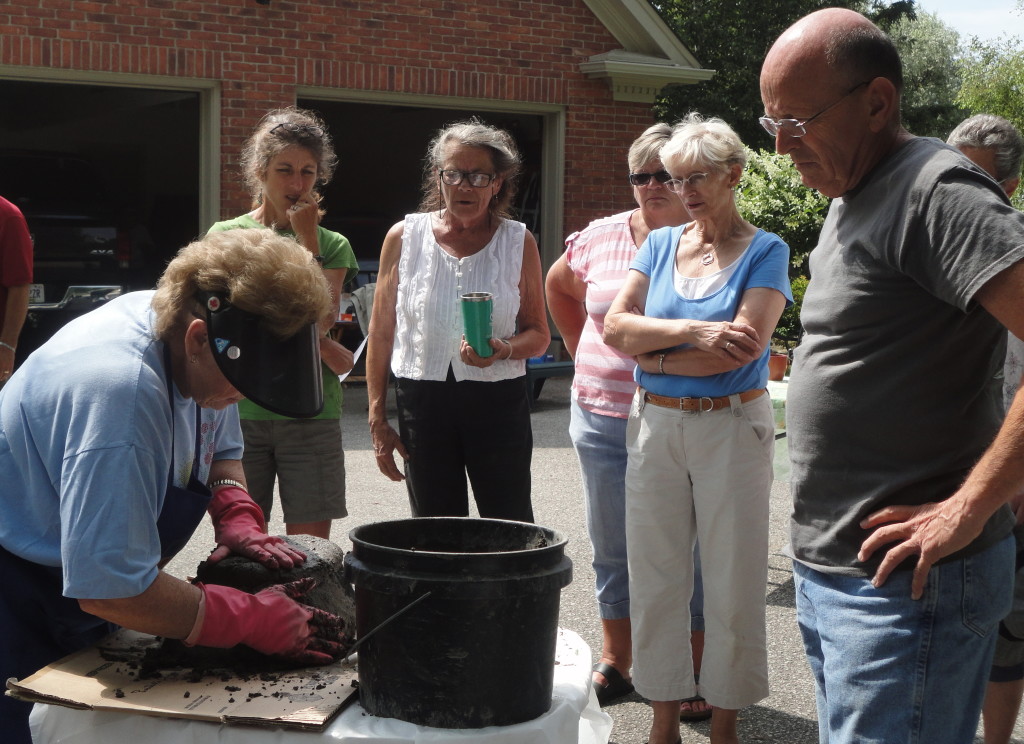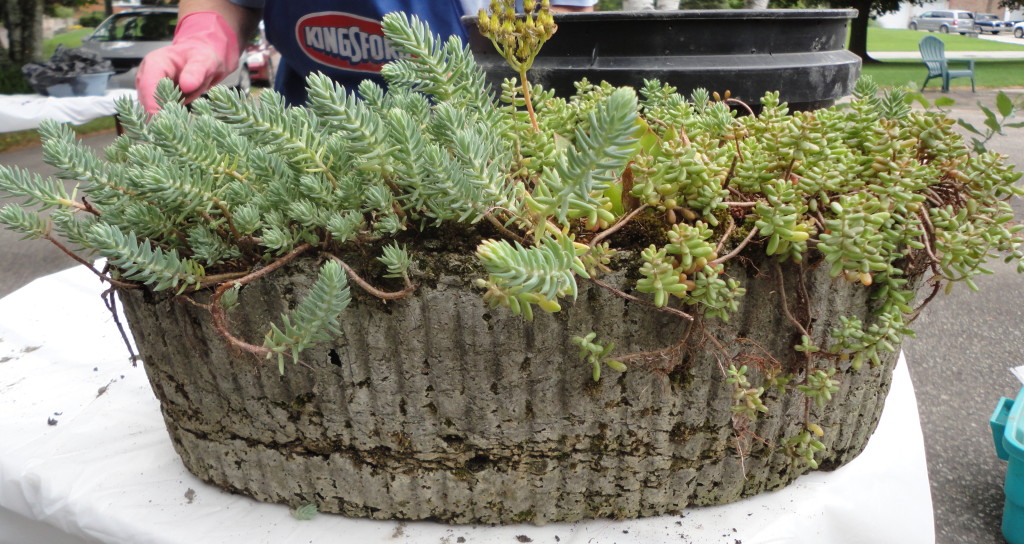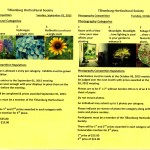Come join our membership as we travel to the Niagara-on-the-Lake area for a fun filled, packed day of activities including Cole’s Garden Centre, two wineries and shopping. Prior to coming home, we will dine at the Old Winery Restaurant known for its’ fresh Mediterranean Cuisine inspired by the Tuscan countryside, located in the heart of Niagara -on-the-Lake. Please click on link to view itinerary.
Category Archives: News
November 3rd meeting – Christmas Urn Demonstration
Come out and join us at our November 3rd meeting, at the Senior Centre at 7:30 p.m. as we watch Sonja Eikelboom, from Eising Garden Centre create a Christmas urn. As we have done previously in the past, the completed project will be won by a lucky member of the Tillsonburg Horticultural Society
Fall is for making your garden amazing
It’s Still Just Dirt – September 2015, The Tillsonburg News
by Penny Esseltine
Jim Stinson is the go-to-guy at Canadale Nurseries in St. Thomas. He’s the one who can answer all of your horticultural questions. Jim has worked at Canadale for 30 years and he visited our Horticultural Society’s first post-summer meeting to tell us why fall is for making your garden amazing.
Jim says nurseries like Canadale reduce their plant prices by 20, 30, 40 and even 50 per cent at this time of year. “You can take advantage of the great prices at your local garden centres right now,” he says, “to add interesting new plants to your garden spaces.” Look for shrubs like fothergilla (bottle brush), sweetspire, oak-leaf hydrangea and viburnum, and perennials that bloom in the fall like toad lilies and fall anemones. “Fall leaf colour can be stunning.”
Here for your inspiration are just some of Jim’s fall gardening recommendations.
Clean out annuals. Toss your annuals, soil and all into your composter or onto your compost pile. They are done for the year.
Plant. Fall is the best time of the year to plant trees, shrubs, and perennials.
Refresh containers with fall colours. Replace tired old annuals with beautiful fall mums, asters, kale and peppers. Add gourds, pumpkins, leaves and branches. Focus on fall before you prep your containers for winter display.
Dig, divide, and conquer perennials. September is a great time to divide irises, peonies, daylilies, sedum and hostas. Dividing now will give them time to re-establish and they will grown twice as nice in the spring. “As a rule of thumb,” Jim says, “perennials that bloom in the spring should be divided in the fall. Perennials that bloom after mid-June are best divided in the spring.”
Jim says there’s no need to cut perennials back in the fall. Again, his rule of thumb, “if they look good leave them. If they look bad then cut them back.” Leave coneflowers because the birds will feast on the seeds in the flower heads through the winter.
Protect tender roses. In late fall hill up soil and mulch around rose bushes or cover them with rose covers. Clean up fall leaves that can be diseased. Attach climbing roses to supports. Jim says pruning your roses is usually best left until spring.
Improve your lawn. You can improve your lawn by sowing grass seed Jim says. As well he recommends fertilizing your lawn twice in the fall, both at Labour Day and again after Thanksgiving. “The after-Thanksgiving fertilizer will start to work quickly in the spring.”
Protect your garden from winter’s worst. “Keep watering until you are green in the face,” Jim says. Most plants need lots of moisture going into winter. This is especially true for evergreens that are susceptible to desiccation, winter burn, or winter kill. Regular watering will reduce the stress on your plants.
Evaluate your garden. Look at the successes you’ve enjoyed in your garden this year and consider the failures Jim says. “Consider what worked and what didn’t work and why. Make notes and sketches to help plan for next year’s garden changes.”
“Invite constructive criticism,” Jim says. “I want an artist to come over and tell me how to improve my garden. They see things differently.” Ask someone who has a different perspective to tell you what they like and what they would change about your garden.
Think spring. Spring flowering bulbs like tulip, daffodil, crocus, hyacinth, allium, and lilies can go in the ground now. Jim’s advice it to outsmart squirrels with squirrel-resistant bulbs. He says, “Cover your tracks by putting leaves over where you plant bulbs. Squirrels are smart and look for disturbed soil.”
The Tillsonburg Horticultural Society meets the first Tuesday of each month in the Senior Centre Auditorium at the Tillsonburg Community Centre. For additional information about the society visit tillsonburghorticultural.ca.
October 6th Meeting
You Can Make Hypertufa Pots at Home
It’s Still Just Dirt – August 2015, The Tillsonburg News
by Penny Esseltine
Helen Smith is a 20 year Master Gardener, a member of both the Elgin County Master Gardeners, and Aylmer Horticultural Society. As well she has been teaching hypertufa pot making for 18 years. Members of the Tillsonburg Horticultural Society were the beneficiaries of her hypertufa experience as she lead a pot-making workshop for us earlier this month.
The term hypertufa refers to a type of artificial stone and comes from a combination of tufa which is a natural volcanic rock and hyper meaning extremely. Hypertufa pots are extremely rock-like containers. They’re beautifully natural looking, hardy, relatively light-weight and Helen says you can leave them outside through the winter. The demonstration piece that Helen brought to show us was made in a kidney-shaped mould originally used for water plants and it was planted full of sedum and other succulents.
You can use almost anything that has an interesting shape for a mould. Things like nursery pots, bins, boxes, plastic containers, pails – you choose. Helen recommends starting with something small. First off line your container with a plastic bag. A garbage bag will work well for this. The plastic lining makes it easy to get the pot out of the mould.
Helen says the mix is very important. The basic ratio of ingredients is two parts peat moss, one part portland cement and one part course sand, vermiculite or perlite. For smaller amounts you can mix this together in a bucket. For our group of more than 20 people making pots, the ingredients were mixed together in a wheelbarrow with a short-handled garden hoe. You can also do the mixing with your hands but be sure to wear rubber gloves because the cement will dry them out.
After the dry ingredients are mixed together next comes the water. Add small amounts at a time. “You don’t want the mixture to be either soupy or dry,” Helen says. “It should be the consistency of cottage cheese and if when you squeeze a handful a little water comes out that’s good.” The basic ratio for water is one to one-and-a half parts.
Once the mixture is prepared it’s time to start filling your mould. Helen’s instructions are to “Scoop the mixture into the mould and pack it in the base and around the edges. Small pieces of chicken wire can be pressed into the sides and base for stability and these are placed in the middle of the mix.” Continue adding mix until it is one-and-a-half to two inches thick in the base and around the sides.
“As gardeners,” Helen says, “we know how important drainage is.” Be sure to press three or four holes into the bottom of the pot using your finger or a piece of dowelling. Lastly cover your piece with plastic and set it in a shady area, or a garage, to cure for 24 to 36 hours. “The pot will be heavy to start but not so much when it dries out,” Helen says.
Turn your mould upside down to remove your pot. You can use a wire brush to rough up or make markings on the outside. Use sand paper to smooth off roughened edges. Sit your pot on a board in the shade, or again the garage. It will take about two more weeks to cure.
“It’s not rocket-science,” Helen says. “In the end your hypertufa pot should resemble natural-looking stone.” You can plant it full of things like hens and chicks, sedum, mosses, portulaca, creeping phlox, ivy, primrose, miniature hostas, or bulbs like snowdrops, crocus and narcissus.
Natural looking hypertufa pots were a big attraction on the Horticultural Society’s Buffalo National Garden Tour last summer. Making them here at home in a large group on a sunny morning with Helen’s simple instructions was as easy as pie.
You can use these basic instructions or look for more complex ideas on line by googling hypertufa pots. Up pops information from Martha Stewart, Lowe’s Building Centre, Fine Gardening magazine – take your pick. You can add embellishments, press in shapes, even colour the mixture if you like. Hand-made hypertufa pots are guaranteed to add much natural interest to your garden spaces.
The fall season for the Tillsonburg Horticultural Society comes quickly with the September General Meeting scheduled for Tuesday, September 1. Mark your calendars. For additional information visit tillsonburghorticultural.ca.
September 1st Meeting
Please join the Tillsonburg Horticultural Society at their monthly meeting on Tuesday, September 1, 2015 at 7:30 p.m. in the Senior Centre to hear Jim Stinson (Assistant Manager, Canadale Nursery, St. Thomas) speak on “Getting Ready for Winter: Fall Gardening”.
Every bud gives beauty for a day
It’s Still Just Dirt – July 2015, The Tillsonburg News
by Penny Esseltine
David Ross says there aren’t many gardens that don’t have a lily or two, but he himself has quite a load. In fact this summer he says he probably has about 60 different varieties in his Straffordville garden. Lily season is almost at its peak. Lilies are tall stately plants that carry a number of large, trumpet shaped blooms on each flowering stem. Each stem can be anywhere from two feet to six feet high. Some are lilies (Lilium) but more are daylilies (Hemerocallis). You can tell the difference because lilies have leaves coming up the stem about every two inches whereas the leaves of daylilies sprout from the clump.
Most people are familiar with the orange daylily that grows along roadsides for a few weeks each year. David says they’re “indestructible and very showy.” Some people call them ditch lilies but like David, I have some growing in my backyard. In fact they have been growing back there, hiding the composters, for decades. They never fail, have been blooming for three weeks now, and still look lovely.
Hemerocallis is a Greek word meaning beautiful for a day. Each daylily blossom lasts only one day but each stem bears many buds.
David says daylilies are a good choice for our area with our wide swings in temperature. There are many hybrids derived from several different species which bloom at different times from late June well into September. Thus plants are grouped as early, mid, or late blooming and this can give your garden colour all season long.
Colours range from purple, bright red, pink, lavender and peach to orange, gold, and yellow. There are bicolored flowers, fragrant ones, and double ones, as well as huge meaty ones. David says he can’t honestly say he has a favourite among the daylilies in his garden. “Every one brings colour to the party.”
“If you’re not a green thumb,” David says, “try a clump or two of daylilies. You’ll be pleasantly surprised.” Daylilies prefer a sunny position with a little dappled shade during part of the day. When planting a clump of daylilies dig a hole about 18 inches wide and six to eight inches deep. David recommends using triple mix blended with the local soil and add a good pinch of bone meal too to help with starting root growth. Then water the plant in well. “Keep a good eye on the watering,” David says and he recommends using either a slow release pellet fertilizer, or Miracle Grow every three to four weeks. Dividing clumps every four to five years helps to refresh blooming.
David says we should talk too about the true lily (Lilium) species. They come in different categories including Orientals, Asiatics, Tigers and Easter lilies. David says this group is being attacked by the lily beetle which is bright red and about 1/4 inch long. “The lily beetle can easily defoliate a plant in just a few days. It has no natural predators and seems impervious to most treatments. One sure way to get rid of lily beetles is by hand squishing them,” David says. “So be vigilant and inspect plants daily.”
“Fortunately the daylily is not on this pest’s menu,” David says, “so we are free to enjoy the great mix of daylily colours available.”
Because they are so popular, there is lots of information on lily topics on a number of websites David says. He recommends the Ontario Daylily Society and you can visit them at www.ontariodaylily.on.ca.
For information about the Tillsonburg Horticultural Society visit tillsonburghorticultural.ca.
The Fresh Herbs Conundrum
It’s Still Just Dirt – June 2015, The Tillsonburg News
by Penny Esseltine
You don’t necessarily need a garden plot to keep yourself supplied with fresh herbs all summer long. With some soil and a few pots you can turn a sunny balcony, deck, patio or window into your personal herb garden. Herbs are flavour-filled and easy to grow however it’s knowing how to use them that often poses the biggest challenge.
Some of the more common herbs to grow in home gardens include parsley (either curly Italian or flat leaf), basil, dill, rosemary, mint, and thyme. Mint and rosemary are best grown in individual containers but you can easily pack a variety of other herbs into the space of a window box or a large pot.
Chef Les Kozachuk, a graduate of the Stratford Chefs School Culinary Program, has worked in the food industry since 1990. He has applied his craft at restaurants in Toronto, Italy, Ontario’s cottage country, and now in London, Ontario. Les brought his alternative ideas for using home-grown herbs to the Ontario Horticultural Society’s District 10 AGM.
First off Les recommends using fresh herbs to garnish a plate. “You get more punch from fresh herbs if you add them to your food after it’s cooked,” he says. For example:
- Basil is a delicate herb that is best used on the same day you pick it. You can add basil to olive oil and garlic for a basil sauce or pesto. Use whole leaf basil in a caprese salad with tomato, bocconcini, and olive oil.
- Lavender can be used in sweet baking like scones. Serve these with cream cheese and honey.
- Dill works as a garnish with salmon or fish and lemon. It’s also a great addition to a creamy dip served with raw vegetables.
- Parsley is a mainstay of Middle Eastern Tabbouleh salads and Argentinean Chimchurri sauces.
- Chives make a nice garnish. You can add chopped chives to potato salad, mashed potatoes, and soups. They’re also great for omelettes.
- Thyme has a stronger flavour similar to sage, rosemary, and oregano. These herbs can stand heat and are good with food groups like chicken and poultry.
To help you along in your quest to make excellent use of herbs from the garden here are some super quick recipe ideas, compliments of Chef Les.
Make creme fresh by blending together equal parts sour cream and 35 per cent cream. Let it sit on the counter for a day. The enzymes in the sour cream help to thicken the mixture. Serve creme fresh with sliced cucumbers, dill and shrimp.
Prepare a compound butter by starting with one cup of softened butter. Blend in two tablespoons of fresh herbs and the zest of one-half lemon. Shape the mixture like a sausage and put it in the freezer. When you take it from the freezer slice it into coins and put these under the skin of chicken or turkey for a nice herb flavour. Medallions of oregano and gorgonzola butter go well with beef. Simply put a medallion on top of each steak.
To infuse a vinegar with herb flavours start with ordinary white vinegar. Add a few cloves of garlic, then sprigs of rosemary or oregano. Les says to remove the garlic after the beginning stages. Left too long garlic can cause salmonella.
For a Margherita pizza grill a pizza dough crust and add toppings including slices of mozzarella cheese, tomato, and basil.
“Herbs are finished in your garden once summer is over,” Les says. “To preserve herbs you can dry freeze them. Wrap the herbs in paper towels, then foil or saran. Take them from the freezer when you are ready to use them. Chop them up and sprinkle on your food.”
You can infuse herbs like you infuse tea. Make the tea into ice cubes. The flavour is maintained and you can add these cubes to your soups and stews.
Home grown herbs are a great way to add a healthy, flavourful touch to any meal. Rather than having your herbs languish in the garden try using some of our Chef Les tips and enjoy these summer favours all year long.
During the summer the Tillsonburg Horticultural Society meets in different locations away from the Community Centre. In July a members garden tour is planned, and in August it’s a hypertufa pot-making workshop. For additional information check these activities out at tillsonburghorticultural.ca. Regular first Tuesday of the month meetings in the Senior Centre Auditorium will resume September 1.



